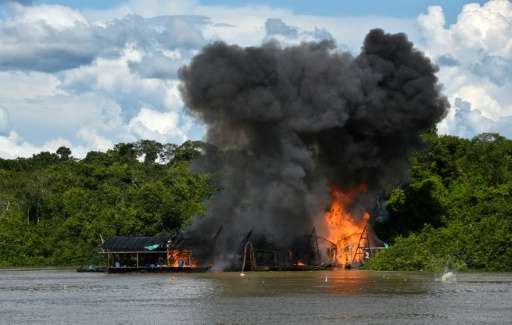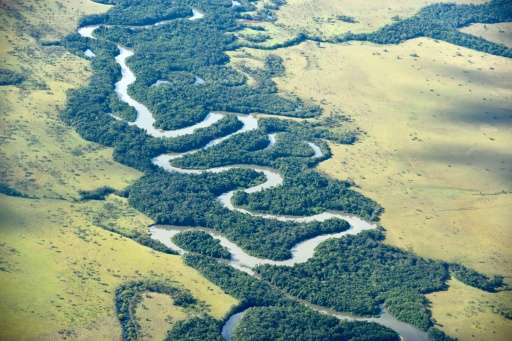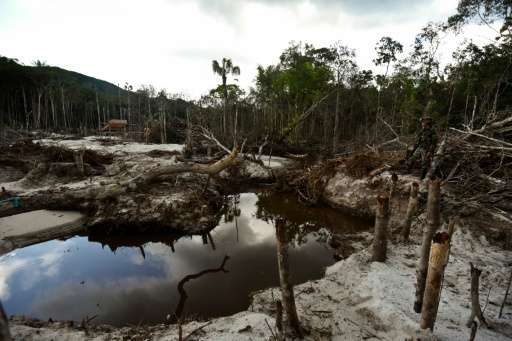'Beaches' from illegal mining scar Colombia's Amazon

It's called a "beach", or "playa" in Spanish, but the swath of sand and polluted water in a remote part of the Amazon jungle in Colombia is not a place of leisure by any means.
Instead, it is the detritus from illegal mining, proceeds of which fund armed groups and guerrillas.
Some 100 kilometers (60 miles) from this "beach" in Colombia's rugged eastern Guainia region, close to the town of Campo Alegre, a dredge that had been pumping masses of riverbed sand mixed with gold stood in the Inirida river.
The dredge was destroyed November 26, in a joint Brazilian-Colombian military operation against clandestine mining.
"Beaches" and dredges dot the area, part of the Puinawai natural park that is one of the biggest protected spaces in Colombia, home to three indigenous reserves.
Sparsely populated, with little government presence and squeezed between neighboring Venezuela and Brazil, Guainia province is looked upon with hungry eyes by those who scoff at a 2012 no-mining ban there.
"Illegal mining activity brings in more money than cocaine," asserted Colonel Jorge Rojas, who coordinated the military operation which resulted in 24 arrests.
A gram of gold is worth $27 in this region, and 10 percent of the mines are run under control of the FARC, Colombia's Marxist rebel group, Rojas said. By comparison, a kilo of cocaine is worth around $965 and is more difficult to sell.

Deforestation
"Eradicating illegal crops means that other revenue sources have been developed," Juan Francisco Garcia, a forest engineer, told AFP.
He said the worst impact of the illicit mining was deforestation, often carried out with heavy machinery, "because it triggers a degradation spiral."
In 2014, 140,000 hectares (346,000 acres)—an area bigger than Hong Kong—have been destroyed in Colombia, half of it in the Amazon forest.
But the total loss is difficult to evaluate.
"Since 2010, we haven't been able to map out the impact of illegal mining activity in the Amazon, because of inaccessibility," said Andres Llanos, from an environmental protection group called Gaia Amazonas.
Authorities blame the phenomenon on the FARC, which for the past three years has been negotiating a peace deal with the government.
But the attorney general's office says "all illegal armed groups" operating in the country are involved, including criminal gangs and drug trafficking organizations.
Colombia's legal mines generated $8.5 billion in 2012, or 2.3 percent of gross domestic product. But more than half the excavations in the country are illegal, according to official figures.
In the region of the Guiana Shield, a 1.7-billion-year-old geological formation in the northeast corner of South America, gold is abundant.
So too is coltan, also known as columbite–tantalite or tantalite, an ore from which a specialized metal is extracted for electronic devices, turbines and alloys resistant to high temperatures.
"The international market for coltan is enormous, from Silicon Valley to Brazil," explained Rodrigo Botero, co-author of "The Paths of Illegal Gold", which studies the issue in Colombia, Peru, Brazil, Ecuador and Bolivia.

Few options for miners
In the Amazon, which covers nearly half of Colombia, signs of the state—police, army, public services—are nearly inexistent.
"We can always tear things down, but when they feel the state is absent they just come back," said Danny Julian Quintana, head of a technical investigation unit in the attorney general's office.
And for local inhabitants, such as those living in Zancudo, a village close to the dismantled dredge, there is no choice other than to work in the illegal mines.
"The options here are to salt fish, tear down vines, or fish for catfish," said Cesar, a 39-year who declined to be identified further for fear of punishment from his employer.
The miners earn around $500 a month, a high wage for the region.
But there is a heavy price to pay too, in terms of health: they spend up to 24 hours plunging underwater with just 15-minute breaks. And in the river they scour "there are no more fish"—killed off by the mercury pollution used to extract gold.
"It's pure slavery," said Rodrigo Botero.
© 2015 AFP



















